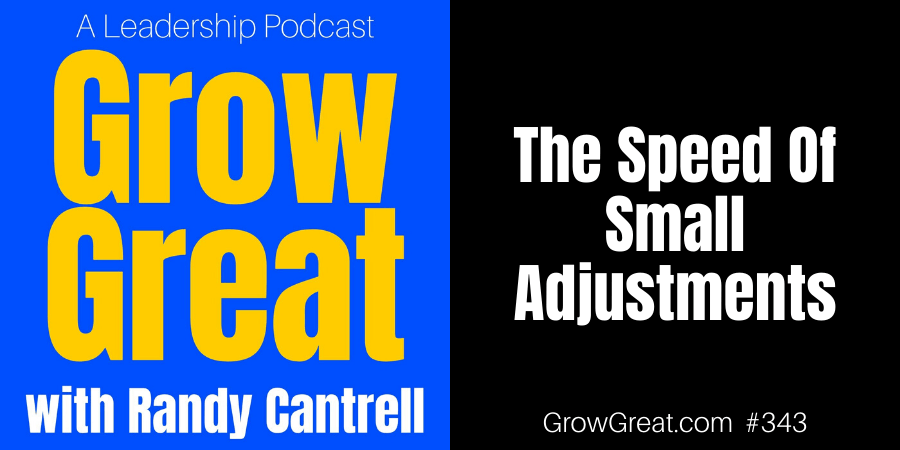Podcast: Play in new window | Download (Duration: 13:59 — 13.3MB)
Subscribe: Apple Podcasts | Spotify | RSS | More
This week the focus has been on details and seemingly small things. Because they can make all the difference.
Let’s end this week with a focus on speed. Especially the speed with which we can make small adjustments.
I wish I were a guitar player, but I’m not. I’ve just dreamed about it since I was young, but I’ve never learned to play. What I have learned is more about guitars than any non-guitar player should know. 😉
I’m that guy. I subscribe and watch all kinds of guitarists on YouTube. I’ve even watched countless videos on the little technical adjustments luthiers and experts at setting up guitars make. Some of these are minimal. Seemingly insignificant. But they make big differences in how the instrument performs.
So it goes with our businesses and organizations. We can make a minor tweak and it can completely alter the results we get. Improvements aren’t always measured by the size of the change or adjustment. Guitarists can turn a tone or volume knob ever so slightly and get a different sound. They can alter how they pluck or strike the strings and again…the sound changes. For the better.
Speed is essential to our success because we’re flying the plane that is our business. Liftoff requires speed. Staying aloft requires speed.
Before little digital tuners were invented – either the ones that attach to a guitar headstock or one that’s on a pedalboard at the feet of the guitar player…tuning was more laborious. Slower. Getting a guitar in tune now is easy and fast (mostly). That’s important because any tune played out of tune sounds…well, awful!
Think of the speed to make small adjustments inside your business as your ability to get into tune more quickly. It’ll help you play better. It’ll result in being able to perform better.
Selling you on the virtues of speed isn’t so hard. I doubt I have to give that much attention. So let’s focus on the smallness of the adjustment. I figure that’s the constraint. To give small adjustments the emphasis they deserve.
If you purchase services or products for your enterprise then you’ve likely experienced cost creep. Suppliers deploy a common practice of incremental price increases. It’s their version of small adjustments because it piles up, adding to their bottom line.
We push back because that cost creep drives down our profits. It takes our business in the wrong direction. That’s why we deploy speed at searching for alternatives that may enable us to creep our costs down instead of up. It’s the push-pull nature of how business works.
Think about what happens when you pull your car in to fill up with gas. Today the price may be $2.89 cents a gallon. Last week it was $2.77. Next week it may be $2.99. You don’t likely think much of it because you need gas in your car. No matter the cost, you have to have it. And those price differences don’t likely create much thought. A 4% swing in one direction or another is no big deal. If you spend $50 to fill up…so what if the next week it’s 4% higher and it costs you $52?
You can’t approach running your business with that mindset though. If you do, you’ll find yourself swimming in red ink. That’s why making small adjustments sooner than later is necessary. I rather choose to think of it as ongoing adjustments. Start and don’t ever stop adjusting in small increments.
In business, we’re basically on this constant quest to drive our costs down and drive our revenues up. That makes this speed thing easier to think about. We put pressure on our costs and expenses to drive them down. We work hard to invest our money in areas where we get the highest return. Simultaneously we’re working to increase our revenues. That can happen with price increases to our customers or it come from higher value and higher price point offerings, or the addition of other (new) offerings. It’s not a complicated formula. We sell more stuff or we sell to more people or ideally, we figure out how to do both. Growth is the deal.
And that’s just applying small adjustments to dollar-related stuff. Like the products we purchase or the products we sell. But there are plenty of small adjustments that can have a big impact on our performance.
In the last decade or so doctor’s offices have made small adjustments that have a big impact on the patient experience. Make an appointment with a doctor today and you’ll probably find the patient paperwork available to download from their website. It’s no longer necessary to arrive 30 minutes early to your appointment so you’ll have time to write your history. Technology has made that adjustment possible.
Look at your systems and processes. I’ll tell you a great place where many of us figure out changes can be made. Our computer systems. Information on one screen still doesn’t translate to another screen in too many systems. Talk to anybody who helps customers and you’ll quickly see the idiocy in action. Small adjustments in how we require information from a customer can become a BIG improvement.
Speed matters because the sooner you save that 4%…or the sooner you begin to collect that extra 4%…well, you get the point. It’s like sewing closed a hole in your pocket where you’re losing nickels and dimes. The dollars add up quickly.
Step 1 – Follow the money
Look at anything and everything. Products, services, processes, systems. Pour over the line item listing. Look at the biggest line items and work your way down. Incremental improvements in these areas will provide the biggest impact.
Step 2 – Follow the friction
We’ve talked about friction a lot and for good reason. It’s a killer when it comes to pleasing customers. Find the friction that you’re exposing your customers to and start making small (big if you can) adjustments to reduce or eliminate it. Keep at it. Chase it hard.
Drive down (and out) the friction experienced by your prospects and customers.
Look around at what’s happening at retail. Stores where shoppers enter, select their merchandise and walk out. Everything happens with invisibility. Calculation of what the customer purchased. Payment. It’s seamless. It’s here and it’s going to become mainstream because we hate taking the time to overcome friction. Get busy getting faster at making small adjustments, then keep making them because the compound effect of small adjustments results in BIG improvements.
Step 3 – Put everything on trial for its life
Great operators put pressure on everything. Pressure to grow and improve. It all stems from what I probably should say more about – belief that growth and improvement are possible. You must have a mindset that “this” (whatever it is) can be improved. Always made better!
Challenge yourself and your team to get busy finding a way. It’s there. It’s possible. And if you and your team don’t do it, then somebody else will. It should be YOU.
Be well. Do good. Grow great!
Randy

